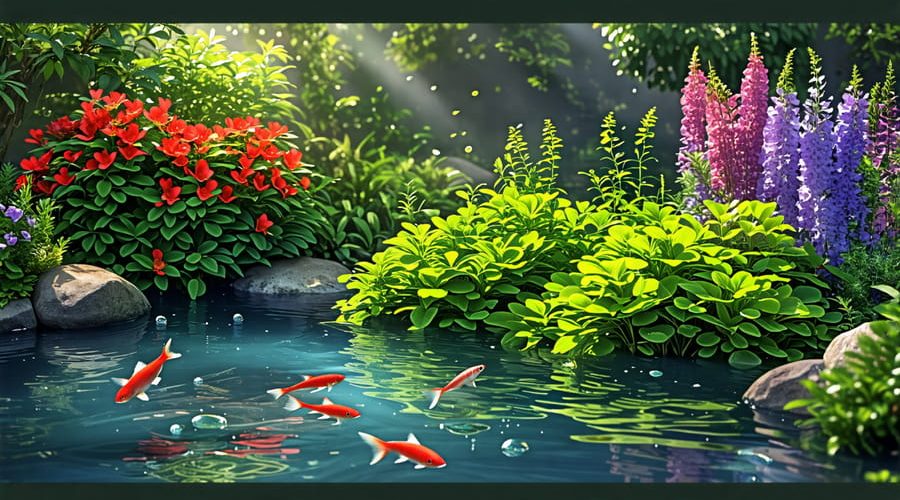
5 Powerhouse Plants That Will Breathe Life into Your Small Pond
Oxygenating plants are the unsung heroes of small ponds, working tirelessly to maintain a healthy and thriving aquatic ecosystem. These underwater wonders provide life-sustaining oxygen, filter out harmful toxins, and create a lush, serene environment that captivates the senses. By strategically incorporating the right oxygenating plants into your small pond, you can transform a stagnant water feature into a vibrant, self-sustaining oasis teeming with aquatic life. Dive into the world of pond plants and discover how these submerged marvels can breathe new life into your backyard sanctuary.
Hornwort (Ceratophyllum demersum)
Hornwort (Ceratophyllum demersum) is a versatile and highly effective oxygenating plant for small ponds. Its finely dissected leaves are arranged in whorls around the stem, giving it a distinctive bushy appearance. Hornwort is a fast-growing plant that can reach lengths of up to 10 feet, making it an excellent choice for quickly establishing a lush underwater environment.
One of the most remarkable features of hornwort is its ability to absorb nutrients and carbon dioxide from the water while releasing oxygen through photosynthesis. This process helps maintain a healthy balance in the pond ecosystem, promoting clear water and reducing the risk of algae blooms. Hornwort’s dense foliage also provides valuable shelter and spawning sites for small fish and aquatic invertebrates.
Hornwort is adaptable to various growing conditions and can thrive in either floating or anchored positions. When left to float freely, it creates a visually appealing surface cover that helps shade the pond and maintain cooler water temperatures. Alternatively, you can anchor hornwort to the bottom of the pond using weights, allowing it to grow upwards and create vertical interest.
Caring for hornwort is relatively simple, as it does not require substrate and can obtain nutrients directly from the water. However, it’s essential to monitor its growth regularly and remove any excess plant material to prevent overcrowding. Hornwort prefers full sun to partial shade and can tolerate a wide range of water temperatures and pH levels.
With its exceptional oxygenating capabilities, easy care requirements, and versatile growth habits, hornwort is an ideal choice for small pond owners looking to create a thriving and visually stunning aquatic environment.

Anacharis (Egeria densa)
Anacharis, also known as Egeria densa, is a popular oxygenating plant for small ponds. Its lush, green foliage not only adds a vibrant aesthetic to your water garden but also plays a crucial role in maintaining a healthy pond ecosystem. What sets anacharis apart is its exceptional ability to produce oxygen through photosynthesis, ensuring your pond remains well-aerated and supportive of aquatic life.
One of the most remarkable features of anacharis is its rapid growth rate. This fast-growing plant can quickly establish itself in your pond, providing ample oxygenation and creating a nurturing environment for fish and other pond inhabitants. As it grows, anacharis also helps combat algae growth by absorbing excess nutrients from the water, acting as a natural filter to keep your pond clean and clear.
While anacharis offers numerous benefits, it’s essential to be aware of its potential for invasiveness. If left unchecked, this plant can quickly take over your pond, outcompeting other aquatic plants and potentially disrupting the balance of your ecosystem. To prevent this, regular pruning and management are necessary to keep anacharis under control and maintain a harmonious pond environment.
When incorporating anacharis into your small pond, it’s best to plant it in bunches or weighted bundles to anchor it in place. This versatile plant can thrive in various lighting conditions, making it suitable for both sunny and partially shaded ponds. With its hardy nature and adaptability, anacharis is an excellent choice for beginners and experienced water gardeners alike, providing a simple yet effective solution for oxygenation and nutrient management in your small pond oasis.

Water Wisteria (Hygrophila difformis)
Water wisteria (Hygrophila difformis) is a stunning aquatic plant that adds a delicate, lacy charm to any small pond or water garden. Its soft, feathery leaves sway gracefully beneath the water’s surface, creating an enchanting underwater landscape. Beyond its visual appeal, water wisteria is a powerful oxygenator, helping to keep your pond water clean and clear. As it grows, it absorbs excess nutrients and carbon dioxide, releasing vital oxygen for fish and other aquatic life to thrive.
One of the best aspects of water wisteria is its adaptability to various conditions. Whether your pond receives full sun or partial shade, this resilient plant can flourish. It is also relatively undemanding in terms of water quality, making it an excellent choice for beginners and experienced pond enthusiasts alike.
To incorporate water wisteria into your small pond, simply plant the stems directly into the substrate or anchor them to the bottom with small weights. As the plant matures, it will develop a robust root system, firmly establishing itself in your pond. Regularly trimming the stems will encourage bushier growth and prevent the plant from overtaking the entire pond.
With its lush foliage, oxygenating properties, and easy care requirements, water wisteria is a must-have for any small pond or water garden. Its presence not only enhances the aesthetic appeal of your outdoor space but also contributes to a healthier, more balanced ecosystem. Embrace the beauty and benefits of water wisteria and watch your pond transform into a serene oasis teeming with life.
Dwarf Sagittaria (Sagittaria subulata)
Dwarf sagittaria (Sagittaria subulata) is a charming and versatile oxygenating plant that’s perfect for small ponds and water gardens. Despite its compact size, reaching only 4-10 inches tall, this grass-like aquatic plant packs a powerful punch when it comes to oxygenation efficiency. Its slender, submerged leaves work tirelessly to infuse your pond with life-sustaining oxygen, creating a healthy environment for fish and other aquatic inhabitants.
One of the most appealing aspects of dwarf sagittaria is its ability to provide shelter and habitat for a diverse array of tiny aquatic creatures. From microscopic invertebrates to juvenile fish, this plant’s dense foliage offers a safe haven where these organisms can thrive. By incorporating dwarf sagittaria into your small pond, you’re not only enhancing its aesthetic appeal but also fostering a vibrant and balanced ecosystem.
Planting dwarf sagittaria is a breeze, even for beginners. Simply place the plant in a shallow area of your pond with a depth of 4-18 inches, ensuring that it receives adequate sunlight. As the plant establishes itself, you’ll notice its leaves spreading gracefully beneath the water’s surface, creating an enchanting underwater landscape that will captivate you and your guests.
Whether you’re a seasoned water gardener or just starting out, dwarf sagittaria is an excellent choice for small-scale ponds. Its low-maintenance nature, combined with its exceptional oxygenating capabilities and habitat-providing properties, make it a must-have for any pond enthusiast looking to create a thriving and visually stunning aquatic environment.
Red Ludwigia (Ludwigia repens)
Red Ludwigia (Ludwigia repens) is a stunning addition to any small pond, offering a vibrant burst of color with its striking red foliage. This versatile aquatic plant not only enhances the visual appeal of your pond but also serves as a powerful oxygenator, improving water quality and supporting a healthy ecosystem.
One of the most attractive features of Red Ludwigia is its ability to add depth and dimension to your pond’s aesthetic. Its lush, red leaves create a captivating contrast against the green foliage of other pond plants, making it a focal point that draws the eye and adds visual interest. Whether planted in clusters or strategically placed as accents, Red Ludwigia’s bold hue is sure to make a statement in your water garden.
Beyond its beauty, Red Ludwigia is also a valuable asset when it comes to maintaining a balanced pond environment. As an oxygenating plant, it actively releases oxygen into the water during photosynthesis, helping to keep the water well-aerated and promoting the growth of beneficial bacteria. This, in turn, supports the overall health of your pond’s inhabitants, including fish and other aquatic life.
Planting and caring for Red Ludwigia is relatively straightforward, making it a great choice for both novice and experienced pond enthusiasts. It thrives in a variety of water depths and can be planted directly in the pond substrate or in submerged pots. To maintain its vibrant color, ensure that your Red Ludwigia receives adequate sunlight, as it requires a minimum of 4-6 hours of direct sun each day. Regular pruning will also encourage bushier growth and prevent the plant from becoming overgrown.
With its striking appearance, oxygenating capabilities, and ease of care, Red Ludwigia is a must-have for any small pond looking to enhance both its visual appeal and ecological balance. Embrace the beauty and benefits of this remarkable plant and watch your pond come alive with a pop of captivating red hues.

Conclusion
Including oxygenating plants in your small ponds offers numerous benefits for the health and beauty of your aquatic ecosystem. These plants help maintain water quality, reduce algae growth, and provide a natural habitat for fish and other pond life. With a wide variety of oxygenating plants available, you can choose the ones that best suit your pond’s conditions and personal aesthetic preferences. Whether you prefer the delicate beauty of water lilies or the vibrant foliage of submerged plants, there’s an oxygenating option that will enhance the visual appeal and ecological balance of your small pond. So go ahead and experiment with different combinations to create a thriving and enchanting aquatic oasis right in your own backyard!
